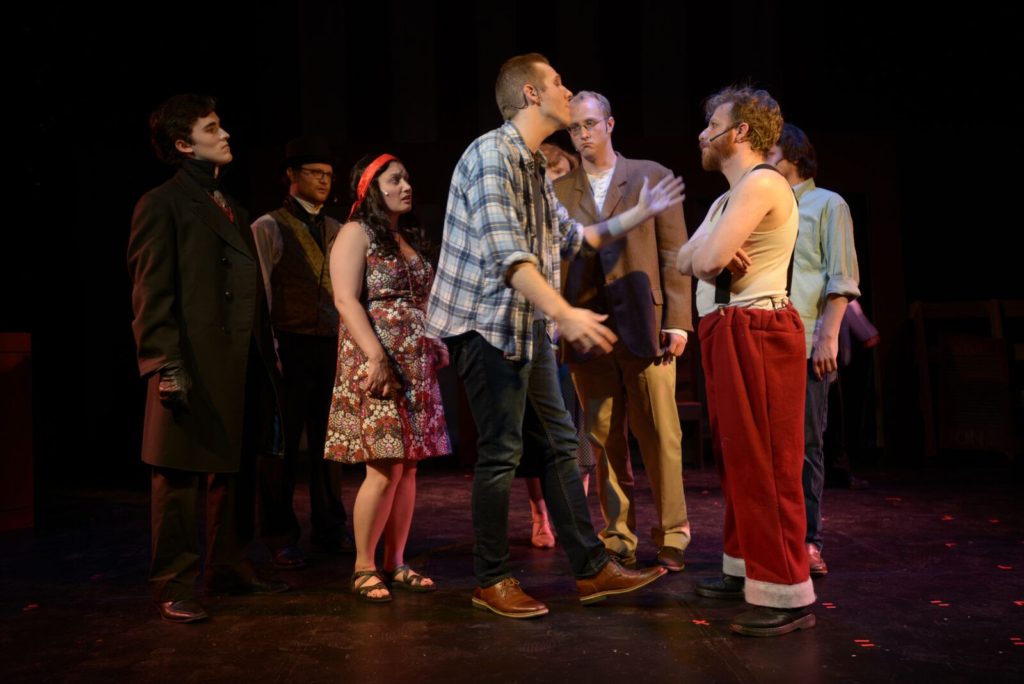
Photo credit: Chantal Acacio; it’s clobbering time.
Presented by The MIT Musical Theatre Guild
Music and Lyrics by Steven Sondheim
Book by John Weidman
Directed by Matt Putnam
Vocal Direction by David Favela
Music Direction by Marek Subernat
September 2 – 17, 2016
MIT Kresge Little Theatre
48 Mass Ave, Cambridge, MA
MIT Musical Theatre Guild on Facebook
Review by Danielle Rosvally
(Cambridge, MA) As an American history buff (can you call yourself a “buff” anymore when you’re technically a professional historian?), I will be the first to admit that Assassins holds a special place in my heart. Who else but the dynamic Steven Sondheim could take a subject matter like the murder of the president of the United States, and write a poignant, witty, yet ever-so-tenaciously perky musical about it? The MIT Musical Theatre Guild has put together a fine production of the show, well worth your time despite the beginning-of-semester crunch.
There are some incredibly talented voices in this production. Nick Stevens as the Balladeer has more power than it seems even he would realize. Brandon Sanchez plays John Wilkes Booth like he was born to the part (and he even looks eerily reminiscent of the famous murderer; take that from a girl who’s spent the better part of five years studying portraits of JWB and his family). Tyler Crosby is delightfully eccentric and caustically energetic as Charles Guiteau. Paul Gallagher, if a little hesitant at first, nails Leon Czolgosz. Megan O’Leary plays the quirkiness of Sara Jane Moore as believable humanity. The ensemble has to be strong for this play to work, and it’s strong alright. This cast’s rendition of “The Gun Song” is simply astounding; clearly and roundly sung with beautiful and precise harmony (just like Sondheim intended).
Hallie Voulgaris is the true unsung hero of this production. Her lighting design takes what might otherwise be a humdrum stage picture and transforms it into a breathing piece of art. Thoughtful and articulate, the lighting of this piece is astounding in its attention to detail and ability to add cinematic dimension.
I’m not sure who to credit for this, but the bios in the playbill were some of the most engaging and entertaining I’ve ever read. I can honestly say that this is the first time in a long career of theatre that I have attended a piece and been entertained before a single word was spoken. Thanks for that touch, MIT Musical Theatre Ensemble. It did not go unnoticed.
There were a few early-run hiccups in the performance I attended. The first several set changes were carried out in awkward silence rather than the rousing background vamping one would expect from a musical with a full on-site orchestra. Hopefully that will work itself out as the run matures. There were a few odd prop decisions made as well. While attention to detail on the part of prop masters Emily Rosser and Rachel Nations was exquisite in some places, it was strangely lacking in others. For instance: despite John Wilkes Booth carrying all period-appropriate hand props (a weathered book, a bloodied rag for a bandage, a pocket watch, etc…) he was asked to write with what was obviously an entirely modern pen in his first scene. Another scene involved a character brandishing a “glass” bottle and threatening violence with it when as part of scripted stage business it had already been knocked off the table and been revealed as (very obviously) plastic. In yet another scene, characters were given muzzle-blocked theatrical firearms with which to shoot at a bucket of fried chicken. Though the guns fired very convincingly, the target (which was only about ten feet from the audience and, thus, in full view) didn’t receive the shots in any way. If the characters were supposed to be “missing” the target, this was not indicated. As a result, one half of the equation was entirely believable, but the other half (the bucket of chicken) broke the illusion. Unfortunately, it is in these tiny moments that immersion becomes broken and what could otherwise be poignant turns to the ridiculous.
These small instances aside, I have to commend the cast and crew for their responsible handling of many theatrical firearms. As a fight director, I have seen good, bad, and ugly representations of firearms onstage. This cast was responsibly trained, maintained good trigger discipline for the duration of the production, and understood the appropriate (and inappropriate) use of this sort of prop. Well done, masters-at-arms Dustin Doss and Kyle Saleeby.
This production is an impressive display of talent applied to an already delightful piece of theatre. I feel it is only responsible to warn potential audiences that the play contains adult subject matter including murder, guns, sexual language, and… well… a lot more guns. If that sort of thing would be disturbing to you, give it a miss. Otherwise: go! There’s no other reason to pass up a dose of history in the form of plucky musical numbers sung by talented local actors?
